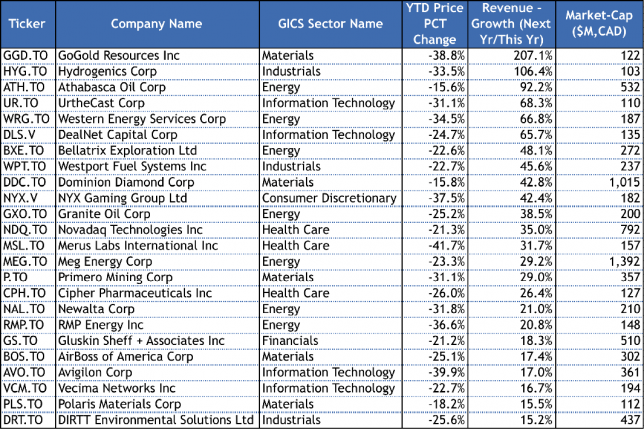With the holiday season quickly approaching, tax loss selling may not be the first thing that comes to mind. Nevertheless, tax loss selling can have an impact on the markets in December and into the New Year.
With that, the chart below shows stocks with market-caps greater than $100 million, that are experiencing an YTD price change of more than -15.0%, but also have revenue growth estimates for next year greater than +15.0%. These names are likely candidates for tax-loss selling; yet offer good growth prospects going into the New Year.
Here is a quick review of the how tax-loss selling works: 
In a non-registered account, when you a sell a security that has declined in value, you realize a capital loss. You can use these to offset any capital gains you’ve incurred in the current year, which can reduce your tax bill. Moreover, unused losses can be carried back up to three years, or carried forward indefinitely to offset future capital gains.
Tax loss selling is not a foreign concept to most investors; however, the affect on securities of different market capitalizations is less commonplace. Unlike large-cap stocks, the markets for which are dominated by large institutional investors (many of which operate on different taxable years or are tax-exempt), small-cap stocks are often dominated by retail investors and are most likely to be impacted by tax-loss selling. Any change in behaviour or market sentiment of the retail investor will likely impact the price of small-cap stocks causing them to fall more than the rest of the market as year-end approaches, and then to rise more than the market during January, once tax-loss selling has abated.
The “January effect” refers to the general increase in small-cap stock prices during the month of January, with the phenomenon rooted in tax-loss selling and window dressing. Retail investors who sell a small-cap stock at a loss in December for example, are likely to redeploy capital in January, perhaps even in the same stock or risk category, resulting in large January returns to those areas hurt by tax-loss selling in December. Window dressing occurs when institutional managers sell underperforming stocks and in some cases, purchase better performing names over the last year or quarter.

So what can you expect this year from tax-loss selling and how can you best position yourself? First, the effect tends to be strongest following years in which the market experienced big losses. Canadian healthcare stocks come to mind here. As well, year-end tax-loss selling is traditionally concentrated in the very smallest companies. Here, prices are sensitive to even slight changes in investor behavior so do not be alarmed if December small-cap prices pullback on a lack of fundamental news. Instead, this may be an opportunity to add to such positions with the prospect of larger returns in January. Tax loss impacts do not and will not work every year, but building a bit of a list can help an investor be prepared if any opportunities do arise as we approach the holiday season.
Sign up for the blog below for more updates like this and check out our previous filter featuring shareholder friendly companies.





Comments
Login to post a comment.
Thank you!
Would be interesting to know when these stocks have bottomed due to tax loss selling. I don't have any to sell so the 30 day rule would not prevent me from buying in at the bottom.